Domyślnie WordPress wyświetla twoje wpisy na blogu na stronie głównej. Jeśli jednak tworzysz witrynę internetową dla firmy lub po prostu chcesz dostosować własną stronę główną, możesz chcieć osobnej strony dla sekcji twojego bloga.
Taka konfiguracja nie tylko pomaga utrzymać stronę główną w czystości i skupieniu, ale także zapewnia dedykowaną przestrzeń dla czytelników, aby mogli zapoznać się z treścią twojego bloga.
Aby poprawić komfort użytkowania i utrzymać wyraźny nacisk na naszą ofertę, dodaliśmy oddzielne strony blogów na wielu witrynach internetowych naszych firm partnerskich, w tym WPForms, OptinMonster i All in One SEO. Umożliwia to odwiedzającym łatwy dostęp do treści bloga, przy jednoczesnym priorytetowym traktowaniu głównego celu, jakim jest promowanie naszych wtyczek.
W tym artykule pokażemy dwa sposoby na utworzenie osobnej strony dla wpisów na blogu w WordPress.

Dlaczego warto wyświetlać wpisy na blogu na osobnej stronie?
Strona główna to strona główna Twojej witryny internetowej WordPress i pierwsza strona, którą widzą odwiedzający. Domyślnie WordPress wyświetla twoje najnowsze wpisy na stronie głównej i ma to sens, jeśli prowadzisz bloga.
Ale nie zawsze jest to idealne rozwiązanie dla witryn internetowych małych firm. Prawdopodobnie będziesz potrzebował bardziej angażującej strony głównej, która opowie użytkownikom o twojej firmie, produktach i usługach, pozwoli im dowiedzieć się, jak się z tobą skontaktować i zwiększy konwersję sprzedaży.
Teraz, jeśli chcesz również prowadzić bloga na swojej witrynie internetowej, będziesz musiał udostępnić inną stronę, na której odwiedzający będą mogli przeczytać twoje wpisy.
Mając to na uwadze, pokażemy ci, jak łatwo utworzyć oddzielną stronę dla wpisów na blogu w WordPress.
W tym poradniku omówiliśmy dwie metody i możesz skorzystać z poniższych odnośników, aby przejść do wybranej przez siebie metody. Należy pamiętać, że druga metoda jest najprostsza i oferuje najwięcej konfiguratorów:
Film instruktażowy
Jeśli wolisz pisemne instrukcje, czytaj dalej.
Metoda 1: Tworzenie oddzielnych stron dla wpisów na blogu w WordPressie
Możesz utworzyć oddzielną stronę dla wpisów na blogu przy użyciu domyślnych ustawień WordPress.
Metoda ta wymaga jednak nieco więcej pracy niż metoda 2 i nie oferuje tak wielu opcji dostosowywania.
Tworzenie oddzielnej strony głównej i strony bloga
Po pierwsze, musisz utworzyć dwie oddzielne strony WordPress, które będą używane jako twoja strona główna i strona bloga.
Nie musisz dodawać żadnych treści do tych stron i możesz nadać im dowolną nazwę. Dla przykładu, niektóre witryny internetowe dla firm używają nazwy “Aktualności” dla strony bloga.

Po utworzeniu tych stron, przejdź na stronę Ustawienia ” Czytanie w obszarze administracyjnym WordPress.
Teraz, w sekcji zatytułowanej “Wyświetlanie twojej strony głównej”, musisz kliknąć przycisk “Strona statyczna”.
Następnie możesz wybrać strony Home i Blog, które utworzyłeś wcześniej. Następnie przewiń w dół i kliknij przycisk “Zapisz zmiany”.

Teraz, gdy przejdziesz do ekranu Strony ” Wszystkie strony z kokpitu WordPress, zobaczysz, że strona główna jest oznaczona jako “Strona główna”, a strona bloga jest oznaczona jako “Strona wpisów”.
Kliknij odnośnik “Zobacz” na stronie bloga, aby wyświetlić podgląd.

Wygląd tych stron zależy od twojego motywu WordPress i możesz chcieć skonfigurować te ustawienia.
Na przykład, jeśli twój motyw ma menu nawigacyjne, to powiadomienie, że WordPress automatycznie utworzył strony Blog i Strona główna. Jeśli nie, to zapoznaj się z naszym przewodnikiem dla początkujących, jak dodać menu nawigacyjne w WordPress.
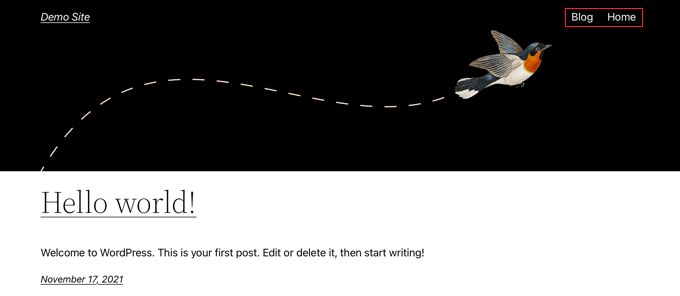
Dostosuj swoją stronę główną do własnych potrzeb
Jak dotąd, twoja nowa strona główna jest pusta. Teraz nadszedł czas, aby dodać informacje o Twojej firmie, produktach i usługach oraz poinformować odwiedzających, w jaki sposób mogą się z Tobą skontaktować.
Możesz dowiedzieć się, jak to zrobić w naszym przewodniku na temat tworzenia własnej strony głównej w WordPress. W Metodzie 1 pokazujemy, jak używać edytora bloków do dodawania obrazków okładek, kolumn, tabel, tekstu i multimediów, galerii i innych elementów.
Wiele kreatywnych pomysłów na konfigurator znajdziesz również w naszym przewodniku na temat tego, jak łatwo i skutecznie edytować stronę główną WordPress.
Dostosuj stronę swojego bloga do własnych potrzeb
Jeśli jesteś zadowolony z tego, jak wygląda twoja strona bloga, to twoja praca jest skończona.
Jeśli jednak obecnie korzystasz z motywu opartego na blokach, to możesz również dostosować konfigurator na swojej stronie bloga, przechodząc na ekran Wygląd ” Edytor z kokpitu WordPress.
Gdy już się tam znajdziesz, wybierz opcję “Strony” z lewej kolumny w pełnym edytorze witryny.

Spowoduje to otwarcie listy wszystkich stron twojej witryny internetowej w lewej kolumnie.
Z tego miejsca wybierz opcję strony “Blog”, a następnie kliknij podgląd strony po prawej stronie, aby rozpocząć konfigurowanie twojej strony bloga.

Możesz teraz kliknąć przycisk dodawania bloku “+” w lewym górnym rogu ekranu i dodać wybrane przez ciebie bloki do strony.
Dodatkowo możesz zmienić kolor tła, tekstu lub odnośników na twojej stronie bloga, klikając ikonkę “Style” w prawym górnym rogu ekranu.
Spowoduje to otwarcie panelu bloków po prawej stronie, z którego można kliknąć kartę “Typografia”, aby zmienić kolor tekstu, kartę “Kolory”, aby zmienić kolor tła, oraz kartę “Układ”, aby skonfigurować wymiary twojej strony bloga.

Po zakończeniu nie zapomnij kliknąć przycisku “Zapisz” u góry, aby zapisać twoje ustawienia.
Teraz możesz przejść na stronę twojego bloga WordPress, aby zobaczyć, jak wygląda.
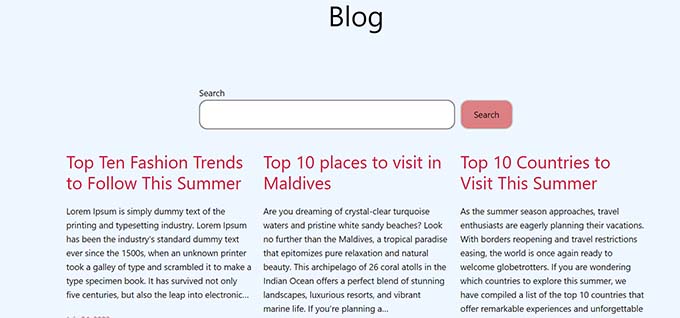
Jeśli jednak korzystasz z klasycznego motywu, będziesz musiał użyć metody 2, aby dostosować stronę wpisu na blogu.
Metoda 2: Tworzenie dostosowanej strony dla wpisów na blogu za pomocą narzędzia Drag & Drop Builder (zalecane)
Wtyczka do tworzenia motywów umożliwia łatwe tworzenie własnego motywu WordPress bez żadnego kodu. Obejmuje to możliwość tworzenia i dostosowywania oddzielnej strony dla wpisów na blogu.
Instalacja kreatora motywów SeedProd
Najpierw należy zainstalować i włączyć wtyczkę SeedProd. Aby uzyskać więcej informacji, zobacz nasz przewodnik krok po kroku, jak zainstalować wtyczkę WordPress.
SeedProd to najlepszy kreator stron WordPress typu “przeciągnij i upuść ” dla firm, blogerów i właścicieli witryn internetowych. Posiada również kreator motywów, który pozwala łatwo dostosować twoją stronę bloga i wiele więcej.
Więcej szczegółów można znaleźć w naszej pełnej recenzji SeedProd.
Po włączaniu przejdź na stronę SeedProd ” Ustawienia, aby wpisz klucz licencyjny. Informacje te można znaleźć na Twoim koncie w witrynie internetowej SeedProd.
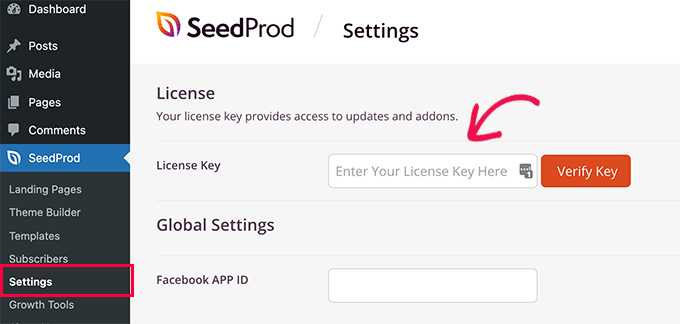
Następnie nadszedł czas na stworzenie własnego motywu WordPress. Jest to znacznie prostsze niż się wydaje.
Tworzenie własnego motywu WordPress
Najpierw należy przejść na stronę SeedProd ” Kreator motywów. Tutaj użyjesz jednego z gotowych motywów SeedProd jako punktu wyjścia. Pozwoli to zastąpić twój istniejący motyw WordPress nowym, dostosowanym projektem.
Można to zrobić, klikając przycisk “Motywy”.
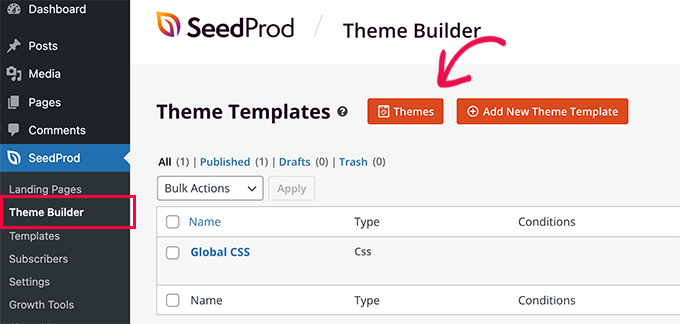
Zostanie wyświetlona lista profesjonalnie zaprojektowanych motywów przeznaczonych dla różnego rodzaju witryn internetowych.
Na przykład istnieją szablony o nazwach “Nowoczesny biznes”, “Agencja marketingowa” i “Motyw pośrednika hipotecznego”.
Zapoznaj się z opcjami i wybierz tę, która najlepiej odpowiada twoim potrzebom, klikając ikonkę znacznika wyboru.

Po wybraniu motywu, SeedProd wygeneruje wszystkie szablony motywów, w tym jeden dla indeksu twojego bloga i jeden dla twojej strony głównej.
Nie są to tylko puste strony, ale zawierają atrakcyjne układy i treści zastępcze, które można łatwo dostosować do własnych potrzeb.

W tym poradniku pokażemy, jak dostosować szablony strony głównej i indeksu bloga.
Możesz także dostosować inne szablony do własnych potrzeb. Aby dowiedzieć się, jak to zrobić, zapoznaj się z naszym przewodnikiem dla początkujących, jak łatwo stworzyć własny motyw WordPress.
Dostosuj swoją stronę główną do własnych potrzeb
Po wygenerowaniu twoich szablonów motywów możesz je edytować za pomocą kreatora motywów SeedProd. Zaczniemy od szablonu strony głównej.
Aby rozpocząć, wystarczy kliknąć odnośnik “Edytuj projekt” na stronie głównej.

Spowoduje to uruchomienie pliku szablonu w kreatorze motywów SeedProd.
Ten prosty kreator typu “przeciągnij i upuść” wyświetla podgląd na żywo twojej strony po prawej stronie i pasek narzędzi blokowych po lewej.
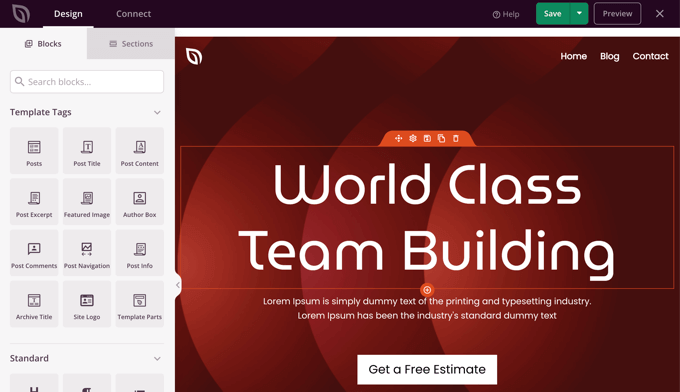
Możesz dostosować dowolny blok, klikając go, przeciągając bloki w górę i w dół za pomocą twojej myszy i dodając nowe bloki do strony.
Napisaliśmy kompletny przewodnik na temat tworzenia własnej strony głównej w WordPress. Po prostu przewiń w dół do metody 2, aby dowiedzieć się, jak dostosować twoją stronę główną za pomocą SeedProd.
Dostosuj stronę swojego bloga do własnych potrzeb
Kreator motywów SeedProd zapewnia również wiele sposobów na dostosowanie strony indeksu twojego bloga.
Zacznij od kliknięcia odnośnika “Edytuj projekt” pod stroną.

Zobaczysz ten sam panel podglądu po prawej stronie i pasek narzędzi po lewej. Stronę bloga można dostosować w taki sam sposób, jak stronę główną.
Na przykład po kliknięciu nagłówka można zobaczyć wszystkie jego ustawienia. Możesz edytować tekst, zmienić wyrównanie i wielkość pisma i wiele więcej.

Po zakończeniu należy kliknąć ikonkę “Bloki”, aby powrócić do paska narzędzi.
Kreator motywów SeedProd oferuje dodatkowe bloki fragmentów szablonu, takie jak blok Wpisy, który wyświetla listę zablokowanych wpisów na twoim blogu.
Blok Wpisy został już dodany do szablonu indeksu bloga dla Ciebie, a w tym szablonie blok wyświetla twoje wpisy w dwóch kolumnach. Możemy to zmienić na pojedynczą kolumnę.
Wystarczy kliknąć na wpis, a następnie zmienić ustawienie “Kolumny” na 1.
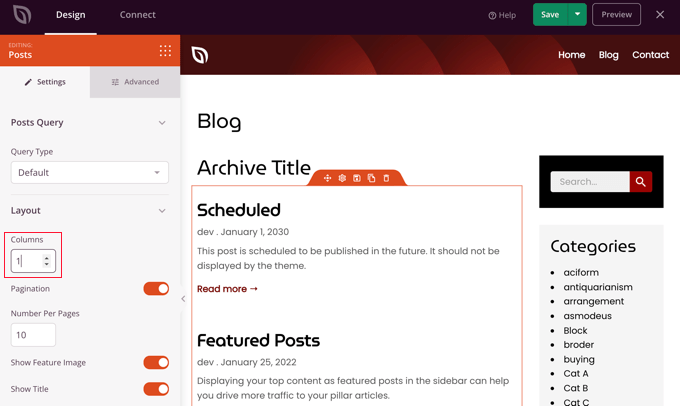
Układ natychmiast zmieni się na jednokolumnowy.
Przewijając w dół ustawienia bloku Wpisy, znajdziesz przełączniki, które pozwalają wybrać, czy wyświetlać obrazek wyróżniający i tytuł wpisu. Możesz także wybrać tagi nagłówka, które będą używane w tytule wpisu.
Dostępne są również opcje wyświetlania różnych metadanych wpisów. Możesz przełączać datę modyfikacji, autora, datę i godzinę publikacji oraz liczbę komentarzy.
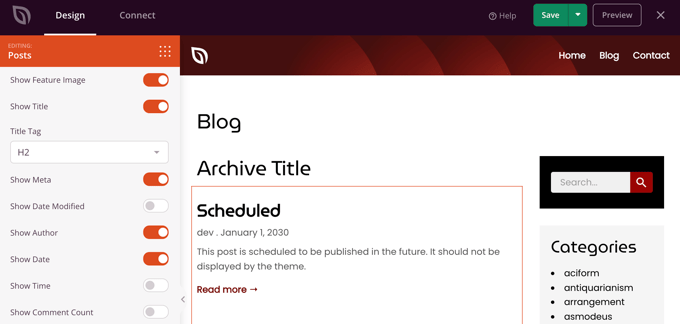
Oto kilka innych sposobów na dostosowanie indeksu twojego bloga:
- Indeks można filtrować według typu treści, kategorii, tagu lub autora.
- Kolejność sortowania wpisów można zmienić.
- Możesz wybrać liczbę wpisów wyświetlanych na stronie.
- Można przełączać zajawkę wpisu i dostosować jej długość.
Po zakończeniu konfiguratora własnej strony bloga, upewnij się, że kliknąłeś przycisk “Zapisz” u góry ekranu. Następnie możesz powrócić do listy szablonów, klikając ikonkę “X”.
Włączanie motywu SeedProd
Po zakończeniu konfigurowania szablonów motywów należy opublikować nowy motyw własny.
Wystarczy przełączyć ustawienie “Włącz motyw SeedProd” na pozycję “TAK”.

Natychmiast pojawi się powiadomienie o konieczności zmiany ustawień strony głównej i bloga WordPress. Po kliknięciu przycisku “OK” ustawienia te zostaną zmienione.
Możesz teraz przejść na swoją witrynę internetową, aby zobaczyć nową stronę główną i stronę bloga. Tak wygląda strona indeksu bloga na naszej witrynie demonstracyjnej.

Bonus: Wyświetl twoje ostatnie wpisy w WordPressie
Po utworzeniu osobnej strony z blogiem, możesz nadal wyświetlać kilka ostatnich wpisów na stronie głównej, aby zachęcić użytkowników do odkrywania większej części twojej witryny.
Aby to zrobić, otwórz swoją stronę główną w edytorze bloków WordPress. Gdy już się tam znajdziesz, kliknij przycisk “Dodaj blok” w lewym górnym rogu ekranu, aby otworzyć menu bloków.
Stąd wystarczy dodać blok “Najnowsze wpisy” do strony. Gdy to zrobisz, możesz dostosować listę ostatnich wpisów, aby wyświetlać zajawki, nazwiska autorów i daty zgodnie z twoimi upodobaniami.
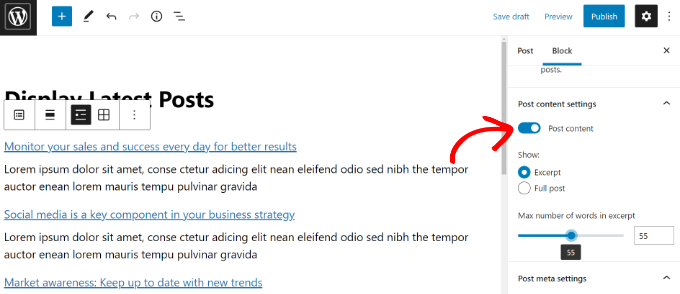
Na koniec kliknij przycisk “Opublikuj” u góry, aby zapisać twoje ustawienia. Teraz niektóre z twoich ostatnich wpisów będą nadal wyświetlane na stronie głównej, aby użytkownicy spędzali więcej czasu na twojej witrynie internetowej.
Więcej informacji można znaleźć w naszym poradniku na temat wyświetlania ostatnich wpisów w WordPress.
Mamy nadzieję, że ten poradnik pomógł ci dowiedzieć się, jak utworzyć osobną stronę dla wpisów na blogu w WordPress. Możesz również dowiedzieć się , jak dodać własny status wpisu dla wpisów na blogu w WordPress lub sprawdzić naszą listę najlepszych wtyczek powiązanych wpisów dla WordPress.
If you liked this article, then please subscribe to our YouTube Channel for WordPress video tutorials. You can also find us on Twitter and Facebook.





Samson
I created a blog using the static homepage setting. But I have an issue. All the details of my blogs are opened in my blog section. My goal is to make it write a little tent about each blog section and skip to the next blog topic so that when clicked on, it would open fully the selected blog
Njofie Wilso
Great video. Really helpful.
I love WPbeginner.
WPbeginner has been a great resource to me.
Chantelle
Thank you so much! Have been struggling like forever to figure this out!!
Patrick
I’m trying to add posts to my blog post page, I went to the reading setting on the dashboard to enable the page I want as my blog page. Then I made a post and posted it to that blog page. It showed up on the right page, however it appears underneath the top header of the page, so the header is overlapping the post. Help!
Sarah
Thank you this was so easy! I’ve been trying to figure this out for ages now and I stumbled across your video.
Wanda
Hello:
Thank you so much. This was very helpful. I’m wondering if there is an easy way to create a header for the Blog page as my picture gets lost when you create a static home page. From what I gather, it can only be coded in HTML so I’m hoping there is more current good news on this.
WPBeginner Support
Hi Wanda,
You can try this, edit the blog page and set the image you want to use in the header as featured image. Most themes use the featured image as header in their page templates.
Admin
Tina Venema
what can i do so my home page feature image does not override the feature image I have chosen for my blog post page called ‘stories’. I have made my homepage static. thanks.
WPBeginner Support
Hi Tina,
It depends on your theme. Normally, if you set a featured image for your homepage then it should only appear on the homepage. However, some users confuse the featured image with the site-wide header image. Please contact your theme’s author for support, they would be able to help you out.
Alison
My posts are showing up as a thumbnail image. I just want it to look like a regular blog. What am I doing wrong?
Paige
This was perfect. Informative and easy to follow. Thanks so much!
Randy
Hi…I have followed the instructions but STILL don’t see my posts on my blog…also, my text in my welcome and about pages is at the bottom of the page…any ideas how to fix both of these…thx so much for your help…
Ellen Thornthwaite
Why doesn’t my WordPress look like this in the video? I have no ‘Reading’ under ‘Settings’. I have created a page called News and I have written a separate blog post but I cannot understand how to link the two.
Binay
Exactly! I am facing a similar problem.
Wood Hughes
Is it possible to have multiple posts pages in WordPress?
My concept is one page for gardening posts, one for real estate advice, and one for commerical land training information.
WPBeginner Support
Hello,
Please see our guide on how to add topics in WordPress navigation.
Admin
Mathukutty P. V.
Just found this tweet and tried. Never knew about creating a page for blog posts. Thanks a lot.
Mary
The information of easy to follow and helped me do what I’ve been trying to accomplish for awhile. Thx
Max Shea
Complicate the simple. Make the simple complicated. That’s WordPress.
tricia norris
Your explanation makes sense, but where does the existing home page go? I am creating a new home page, but does that mean I need to build a new home page?
Micki Allen
Thank YOU!
Anirban Karmakar
Is there any SEO benefits to Create a Separate Page for Blog Posts in WordPress? Or any SEO losses when I change my default Blog Post location to a custom page?
Sally
Hello! This is great…but! Can you help me add a SECOND blog page to my website?
WPBeginner Support
Hi Sally,
If you want to add numbers below blog page, then please see our guide on how to add numeric pagination in WordPress.
Admin
Danielle
How to add a blog page to page builder for mobile menu in wordpress? It seems like The blog page isn’t visible there.
Joan
this article was great. I think I need to start over! cause when I click on blog, the blog I wrote is over all the pictures from the front page and from the one I attached to a particular blog. This is way too hard.
Olivia
Hey, could you please help me? I really want to be able to sort my posts into different pages on my blog to keep things organized. Is this possible? If not, is there any alternative that could help me to post images with captions sort of like “posts” instead of just making the page look like that permanently? I want to be able to view a sort of gallery of images, and when I click on them get the full-screen version with captions. I found a perfect theme to let me do this, but I can’t get these to go anywhere but the front page! I really want to copy these posts onto my different pages.
Kim
THANK YOU. This was driving me nuts and your explanation couldn’t have been easier for this non techie website builder
Mort Wakeland
The info and video seem a bit dated for my WordPress does not have some of the options discussed. The video is pretty good except in places she skips steps. We are beginners, not experts, and we need all the “bread crumbs” we can get.
I followed the directions as best as I could, knowing this latest version of Word Press does not have a lot of the steps mentioned, e.g., there are no “discussions” to uncheck.
When I access my website, there was a static page with only Home listed. Where is Blog?
Reading additional sites, it appears the theme one installs has something to do with what shows and does show on the home screen – correct? To me this is a convoluted mess with no straightforward instructions. Most frustrating. If the theme is important, as some websites suggest, then why is it not one of the first things mention?
For me – I’ve already generated a blog and it works. I need to also generate a webpage for the communications class I’m in. So, with a blog already present, how does one add a static home page, wherein one can access the blog that has already been made in WordPress. Seems straightforward – but it’s not for I cannot find a fix to this question. Any advice, suggestions on sites to read, would be appreciated. This is like making a “mountain out of a molehill.”
Best evening wishes,
Dave
I followed written directions using WordPress 4.9.1 and found the discussions checkbox; try ignoring the video.
To have the Blog page be selectable as the Posts page, you have to create the Blog page first.
Themes may mangle a lot of WordPress instructions, there’s no way an instructional blog can know that, and it might be discouraging to state that at the beginning; this kind of thing is generally normal in many things you can customize.
You can add a static home page in Setttings > Reading as stated in the instructions.
Ern Miller
I created a page called “Blog” and linked to it, but I cannot figure out how to add blog posts to it, except to edit the “Blog” page as a static document. I cannot figure out how to link to blog entries.
IShita
My admin side bar doesn’t show me the reading tab everyone is referring to. I am using WordPress.com and want to post different blog posts to different pages. Just blog posts. Nothing else. Help Please. I have zero background in CSS or anything as such.
Thanks.
WPBeginner Support
Hi IShita,
This article is about self hosted WordPress.org websites. Please see our guide on the difference between self hosted WordPress.org vs free WordPress.com blog.
Admin
Sam Jane Price
Thanks so much for this info. Quick & easy fix
Danielle
I set up my site similar to the video except that I have my posts as News, and they are pushed to the News page. However, once a user navigates away from the homepage to the News page, the menu breaks and they cannot get back home, unless by clicking the back button. I know this has something to do with my file hierarchy (as I installed wordpress to my server manually) but I can’t identify where to fix this. Anyone have an idea what I’m doing wrong? Much appreciated!
Vidya Venugopal
Problem solved, Thanks!
Anjali Kulkarni
Still it not clear to me I have my own site at and it has some pages too but I want more pages for different section just like this site has “start here” deal and so on if create pages then how to add that blog to specific page, please explain in details….
gabriel
This solved my problems, thanks
Soren Pejstrup
Thanks for all you great content. I’m shifting fra Joomla to WordPress, and I’m enjoying it – and you’re helping me on the way. Thanks so much.
I’ve build out a couple og blog pages on different sites new.
In Joomla I was used to sort pages with post by popularity so that the most visited (not the newest) where on top.
Do you know how this can be done in WordPress?
Thx Soren
Sara
This was just what I was looking for. I usually use WordPress templates that already have the blog page specified, but now I won’t need to do that. Thanks to your instructions, I can easily do it myself!
Laura
I have all of this set up, but now my header image will not show up on my posts page. It shows up on the backend (I use visual composer). But when I preview my blog page, it takes me to the homepage and when I actually go to my live blog page, the posts are there but not the header image.
Does it have something to do with my theme?
Thank you!
Odinn Burkni
I have the exact same problem. There’s no header image on the blog page even though I have it set up on the page in wp-admin.
Jenn
Thank you! This video was great, exactly what I was looking for!
Musa Hussen
I have static page for home page and blog page for all of default post..Now I want to display some post on my home page. How could I do it. Thanks
WPBeginner Support
Hi Musa,
There are multiple ways to do that. You can use the Display Posts Shortcode plugin. You can also use the Recent Posts Extended Widget plugin.
Admin
peter
hi WP beginners, how can i post multiple posts in a page. i have like sports, tech… but i can only post in the home page. please reply, thanks.
Sian
I don’t most of those settings as my WordPress looks nothing like that. Why is that, what can I do?
WPBeginner Support
Hi Sian,
You are probably using WordPress.com. Please see our guide on the difference between self hosted WordPress.org vs free WordPress.com blog.
Admin
leanne ferguson
I have created separate pages for different subject areas and now want to add multiple posts to each subject area that will have different themes I.e. one of my pages is called museum trips and exhibition’s and on that page I want to add separate blogs or posts about different museums I have visited which will include photographs. how do I do this please?
Rich
Did you ever get an answer?? i am trying to do the same thing…google picks up your comment and brings me to this post.
Steven Denger
Hello Leanne – I have just recently started to use “posts” instead of pages, except for 1 or 2 exceptions. You go into the Posts > Categories and create a parent category: Museum Trips. Then you can create another category and title it “Museums Visitied” (or somenthing of that nature) and make it a parent (by not checking any parent categories).Then when you make a post about Museum trips, check that category box “Museum Trips” in your post editor on the right near the page attributes. As well, when you make “Museums Visited” posts, you can check that box to indicate which category it goes under, which would be Museums Visited. Now go to your “Menus” and create menu items under the “category” panel just under the normal place of menus. You just check the boxes and then click”Add Menu Items” and then they will be linked just as any other menu link on your nav bar. When the menu links are clicked, you will see just the posts features under that particular category. It is a great way to “segment” your contents and organize them.
As you create posts about one subject or the other, just make sure you check which category it goes in and it will show up there in it’s separate feature page, just like you want.
You may have already figured this out, but I just now saw your post so I thought I would answer. Good Luck.
kelsey
HELP!!!!!!!! THIS BROKE MY HOME PAGE!!!!!!!! I’ve now lost my actual home page where is it??? How do I undo this????????
WPBeginner Support
Hey Kesley,
Start the tutorial again and undo the steps you took earlier.
Admin
akhlaq
hello, nice tips.
i would to ask you how to make my url is like this
mydomain.com/tutorial-web/post.html and not mydomain.com/category/tutorial-web/post.html
and if my visitor go to mydomain.com/tutorial-web/ the will find all post with ‘Tutorial Web’ category at that page
sorry for my bad english
Thanks for your tutorial, your website is amazing for beginner like me
Lauren
Hi
This is a very useful post – except when I go on settings there literally isn’t a reading settings section. Can you help me?? I might just be being stupid but I need assistance asap
Thank you
Tirso
Hi, thanks for your information, but I have a problem with the menu on my posts page in my wordpress.
Here is the thing… I created a new page for posts as you said and I set a menu I created for posts and pages (as secondary menu) and everything is fine with the menu until I switch that page to “Posts page” on “Settings > Reading”… When I do that, it changes the menu to my “primary menu” automatically and I don’t know what to do so that it takes the secondary menu…
Hope you can help me!
Donald
I’d actually already done what you said in this video, but isn’t working as I was expecting. It does put the blog to ./blog as expected, however you can still see the blog (and about and contact etc…) on the home page if you scroll down, and I was expecting to ONLY have the Home page visible. i.e. scroll down and only see the bottom of the home page. This is with the Twelve Seventeen theme (not sure if it’s related to that?). Is there a way to make ONLY the Home page display? (from the wording of the settings you’d think that’s what you’re doing, but that’s not what I see when done – see all the same stuff as before, but now the blog has a place of it’s own in addition)
Brittinni
How would you differentiate a home page verses an about page? I’ve read that both have a good bit of overlap.
Krishna Roy
hello WP beginners,
First of all I want to thanks for all wp tutorials. By watching your tutorials i have created a website + Blog . Its working fine. But i want to ask one thing. I have installed “bbpress” plugin for create forum in my website and when new users want to register in my blog then ” bbpress” not sending their passwords to their emails.
Can yo help me for that? how can i configure bbpress properly for new users registration.
WPBeginner Support
Hi Krishna,
Please see our guide on how to fix WordPress not sending email issue.
Admin
Joyce
OMG. Thank you so much. With all the you tube tutorials, there is nothing that I could find that actually detailed this specific required info. I am so glad I found this site. :o)
WPBeginner Support
Hey Joyce,
We are glad that you found this article helpful. You may also want to subscribe to our YouTube Channel for WordPress video tutorials.
Admin
Amanda
Hi,
Thank you, but what about if there is no Template option to choose in Page Attributes? I’m working with Twenty Seventeen and it is not an option.
Mark
Hi,
I have a static front page and a post page.
How do you put a title onto the Blog page?
It’s just it doesn’t flow with the look of the other pages! my site is so you can see what I mean.
Thanks
Mark
Jordan Stocker
This was a life saver – thank you!!
Nancy
Thank you for your help! I was very frustrated until you helped me.
Elakkiya
This page is very helpful to me!!!. Thank you…